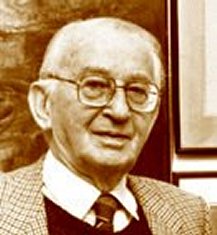|
|
Menahem Avidom (Composer) |
|
Born: January 6, 1908 - Stanislav, Galicia, then Austro-Hungarian Empire
Died: August 5, 1995 - Tel-Aviv, Israel |
|
Menahem [Menachem] Avidom [Mahler-Kalkstein] was an Israeli composer of Russian birth. His mother was a cousin of Gustav Mahler; his adopted surname combines the word ‘Avi’ (‘father of’) with the initials of his children's names. He studied at the American University in Beirut and at the Paris Conservatoire, where his teachers included Rabaud. In 1925 he emigrated to Palestine, where, in addition to his work as a composer, he served as a music critic, secretary general of the Israel Philharmonic Orchestra (1945-1952), chair of the Israel Composers' League (1958-1971) and general director of ACUM, the Israeli performing rights society (1955-1980).
In the late 1930s, after writing early works in an Impressionist style, Menahem Avidom turned towards atonal composition. While studying in Beirut and during a four-year stay in Egypt, however, he became deeply influenced by Mediterranean and Asian folk music and French culture. These influences found their expression in arrangements for the Yemenite singer Bracha Zefira (1939), the Flute Concerto (1944), Symphony No. 1 ‘Amamit’ (‘Folk Symphony’, 1945), Symphony No. 3 ‘Yam tichonit’ (‘Mediterranean Sinfonietta’, 1951) and other works. A use of modal scales, folk-like dance rhythms, oriental melodic motifs and orchestration influenced by Ravel and Les Six are characteristic of these works. Symphony No. 2 ‘David’ (1948-1949) depicts the life of the biblical king, while Symphony No. 5 ‘Shirat Eilat’ (‘The Song of Eilat’, 1956-1957) is a combination of a conventional symphonic form and a song cycle.
In the early 1960’s Israeli music began to move away from regionalism towards international styles and techniques. Influenced by these trends, Avidom turned to 12-note procedures. Enigma (1962), a work that imitates electronic effects, displays his interest in sound patterns: the second movement is an inversion of the first, the fourth an inversion of the third and the fifth a recapitulation of the first. The Symphony No. 7 (1960-1961) features a four-note series (A-B-D-mi) that refers to his name. In 1974, for the first Rubinstein Piano Master Competition, Avidom wrote ArtHur ruBinStEin, six inventions based on the series of notes represented in Rubinstein's name (A-H-B-S-E). The last symphony, No. 10 (1981), combines 12-note procedures and oriental melodies. Bachiana (1984-1985), based on B-A-C-H, was written for J.S. Bach's 300th anniversary.
Avidom's first major opera B'khol dor va'dor (‘In Every Generation’, 1953-1954) describes events in Jewish history. Ha'preida (‘The Farewell’, 1971) creates a strangely unreal atmosphere and a convincing expression of complex psychological situations. His historical opera Alexandra ha'khashmonait (‘Alexandra the Hasmonean’, 1955-1956) won the Israel State Prize in 1961. |
|
Works (selective list) |
|
Stage:
B'khol dor va'dor [In Every Generation] (Spl, L. Goldberg), solo vv, 10 insts (1953-1954)
Alexandra ha'khashmonait [Alexandra the Hasmonean] (op, A. Ashman) (1955-1956)
Haramai [The Crook] (chamber op, E. Kishon) (1966-1967)
Ha'preida [The Farewell] (radio op, D. Hertz) (1969)
Bigdei ha'melekh ha'chadashim [The Emperor's New Clothes] (chamber op, M. Ohad, after H.C. Andersen) (1975)
Me'arat Yodfat [The Cave of Jotapata] (dramatic scene, S. Tanai), S, chamber orchestra (1978)
Sofo shel ha'melekh Og [The End of King Og] (children's op, Tanai) (1979)
Ha'chet ha'rishon [The First Sin] (chamber op, A. Meged) (1980-1981)
Orchestral:
Concerto, flute, strings (1944)
Symphony No. 1 ‘Amamit’ [Folk Symphony] (1945)
Symphony No. 2 ‘David’ (1948-1949)
Music for Strings (1949)
Symphony No. 3 ‘Yam tichonit’ [Mediterranean Sinfonietta] (1951)
Symphony No. 4 (1954-1955)
Symphony No. 5 ‘Shirat Eilat’ [The Song of Eilat] Mez, orchestra (1956-1957)
Symphony No. 6 (1958)
Triptyque symphonique (1960)
Symphony No. 7 ‘Philharmonic’ (1960-1961)
Symphony No. 8 ‘Sinfonietta l'moed’ [A Festival Sinfonietta] (c1965)
Symphony No. 9 (Symphonie variee), chamber orchestra (1968)
Spring, overture (1970)
Symphony No. 10 (Sinfonia brevis) (1981)
Vocal:
Kantatat t'hilim [Psalm Cantata], chorus (1955)
Yud'bet gueva'ot [Twelve Hills] (cantata, R. Freier), Mez, chamber orchestra (1976)
songs: 1v, piano; 1v, string quartet
Chamber and solo instrumental
Concertino, for violin, piano, 1949, orchd (1967)
String Quartet No. 1 (1954)
String Quartet No. 2 (1961)
Enigma, for 5 wind, percussion, piano (1962)
Brass Quartet (1969)
BACH Suite, for woodwinds, strings, piano, percussion, n.d.
ArtHur ruBinStEin, for piano (1974)
String Quartet No. 3 (1979)
Sonata, for viola (1984)
Bachiana, for piano (1984-1985) [arranged for chamber ensemble]
Sonatina, for violoncello (1988)
Triptiyque, for flute, horn, piano (1988)
piano works
MSS in IL-J
Principal publishers: Israel Music Institute, Israeli Music |
 |
|
Source: Grove Music Online (Author: Michal Ben-Zur) Copyright © Oxford University Press 2007-2011 [accessed: July 19, 2011]
Contributed by Thomas Braatz (July 2011) |
|
Menahem Avidom : Short Biography | Bach-inspired Piano Works: Works | Recordings | Other Arrangements/Transcriptions: Works | Recordings |
|
Links to other Sites |
|
Menachem Avidom - Israel Composers' League | Israel (usic Center)
Menachem Avidom (Recollections of Stefan Wolpe) |
Menachem Avidom (Wikipedia) |
|
Bibliography |
|
M. Brod : Die Musik Israels (Kassel, 1976)
A. Tischler: A Descriptive Bibliography of Art Music by Israeli Composers (Detroit, 1988)
Y. Cohen: N'imey Zmirot Yisrael [The heirs of the psalmist] (Tel-Aviv, 1990) |
|
|